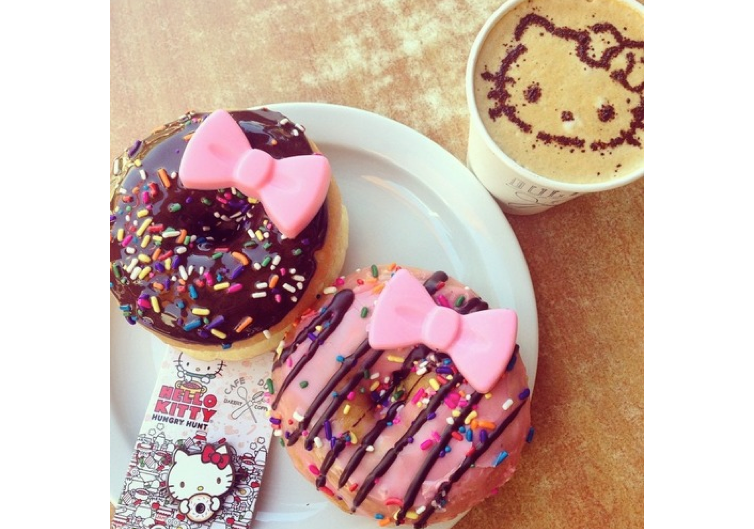by TONY KIM
It was a Saturday night in August, and the Caffebene on Western Avenue in Los Angeles’ Koreatown was abuzz with customers as Crush’s “Hug Me” filled the space with its rhythmic beat. One young woman at a nearby table was coloring a stunningly accurate drawing of three roses a shade of red lighter than her hair. Across the room a couple appeared to be on a first date, as the woman covered her mouth while giggling at her companion’s wild gesticulating. Meanwhile, other customers around the room were deeply engaged in activities ranging from studying complex Excel-like graphs to friends joking around with each other.
This was by no means my first time at a Caffebene, which are about as ubiquitous in South Korea as Starbucks stores are in America. But this was my first time at one in the U.S., where the Korean café chain is launching an ambitious expansion, with more than a dozen stores already open and 86 additional locations slated to open here this year.
It’s part of a larger global scheme to open 500 outlets in over 20 countries by 2015, and a total of 10,000 by 2020. In other words, look out, Starbucks. Bruce Kim, Caffebene’s franchise development director, is quick to point out that Caffebene does in fact beat Starbucks in the number of stores in South Korea—965 to 642.
“Starbucks is not really a café. It’s just a coffee shop,” said Kim, who made a note to compare Caffebene to Starbucks throughout our interview.
Modeled after European-style cafés, Caffebene stores in the U.S. feature a wood-dominant interior, with multiple wooden tables, chairs and bookcases. At one Southern California location, an extra long rectangular table seemed ideal for large-party study groups, as a giant wall clock with Roman numerals kept time. The goal, say representatives of Caffebene, is for people to stay, not just buy their drink and leave. The reasoning is: the longer that customers stay, the more they eat and drink from the menu, and the more profits the store makes.
“Here we offer electricity (for laptops, electronic devices), and we want people to linger and socialize,” said Kim. “There are not enough of these, honestly, that offer people inexpensive choices and a gourmet menu. There’s a niche market for it.”
He said the cafés would like to see its demographic grow, from “hip, young Asian people” to pulling in “anybody under the age of 60.”
The extensive and unique menu may just help in this regard. The menu options are both localized based on popular regional choices and universalized to maintain consistency. There aren’t many cafés that offer banana walnut honey bread, red bean patbingsu, peach berry mojito, Belgian waffles, gelato and a teriyaki chicken sandwich. In addition to the selection of coffee and tea, there is also the unique Misugaru latte, made from multiple grains and quite popular among ajummas for its health benefits.
This past September, the coffee chain was grabbing both local and international headlines, as stores were opening in such diverse locations as California and Missouri to Ho Chi Minh City, Vietnam, and Petaling Jaya, Malaysia. That same month Forbes published an article about Caffebene’s attempt to break into the retail coffee industry in the U.S., with Starbucks and Dunkin’ Brands currently occupying 60 percent of the market. Caffebene’s founder, 45-year-old Sun-Kwon Kim, responded by saying that the company has expanded into countries that already had big coffee chains, but that didn’t stop them from establishing a presence. Kim cited the chain’s Chinese expansion, part of a joint venture that has led to the opening of 423 stores since 2012.

Caffebene stores in Los Angeles (left) and New York City (right).
But Caffebene has also made other kinds of news in recent months. On Aug. 4, the Fair Trade Commission fined the company 1.9 billion won (about $1.8 million), the highest fine meted out by an antitrust organization to a franchise, for unfairly shifting the burden of promotion costs to its franchise shop owners. The Korea Times reported that the company had owners buy their own equipment for interior decorations, which translated into 55.7 percent of its total sales from 2008 to 2012.
In an official press statement, however, Caffebene officials said the company not only received permission for splitting the costs of promotion costs with franchise owners, but also shouldered the costs of other advertisements, promotions and replacement costs amounting to 100 million won. The statement said franchise owners were never forced to purchase their own interior equipment and that alternative options were offered.
FTC issue aside, the next several months could be pivotal for Caffebene as it continues its expansion efforts. It has already opened 1,860 cafés in 14 countries, up from 1,250 at the start of 2014. When asked if the company’s hyper-aggressive goals are realistic, franchise development director Bruce Kim’s easy smile did not waver.
“The rate at [which] we’re growing worldwide, it’s very possible because everything starts to snowball. In the West Coast, we have two stores open, another 10 opening by the end of the year,” said Kim (Since the interview, a third store, in the L.A. suburb of Gardena, has opened and KoreAm was informed that Kim is no longer with Caffebene.).
“We’re being very careful in the beginning because we want to set a strong foundation, but once it starts happening, there’s momentum, and it’ll carry us to 10,000.”
___
Photos courtesy of Caffebene
This article was published in the October/November 2014 issue of KoreAm under the title “Wakd Up and Smell the Competition” Subscribe today! To purchase a single issue copy of the magazine issue, click the “Buy Now” button below. (U.S. customers only. Expect delivery in 5-7 business days).






